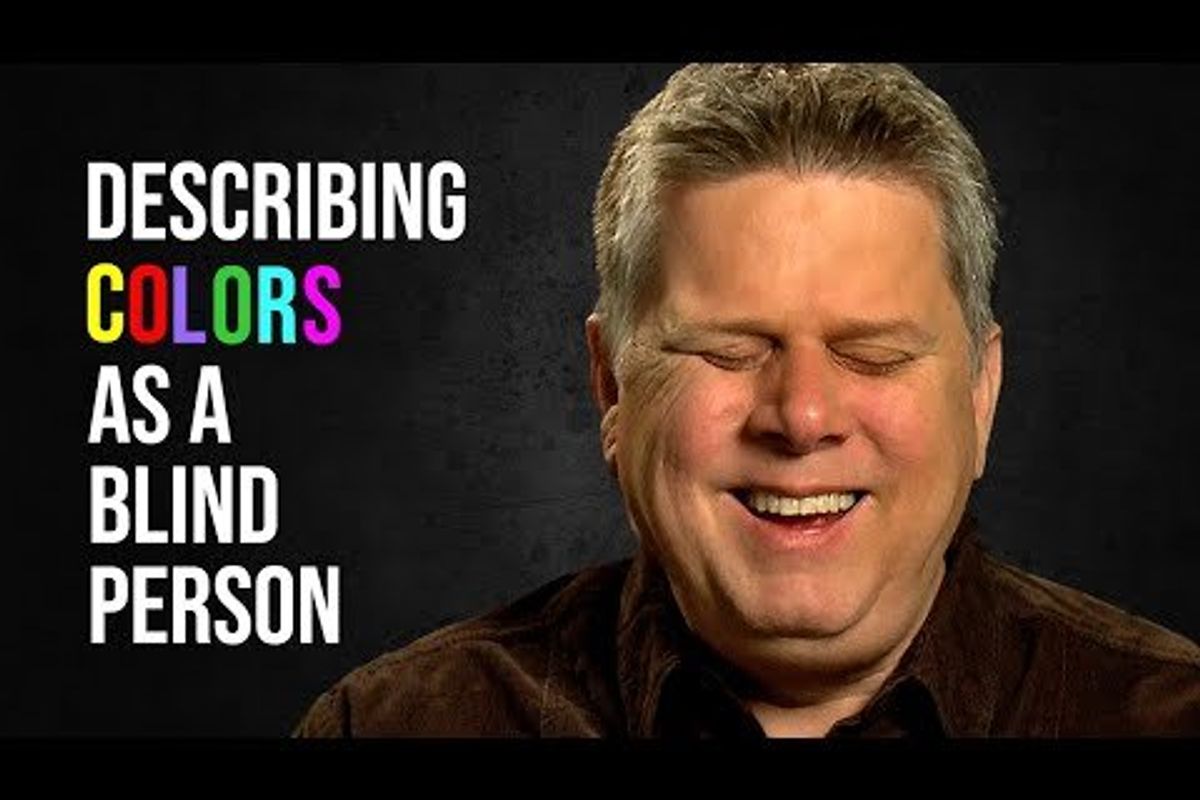A man who was born blind describes how he perceives of colors and it's mind-bending
"How can the sky and ice be the same color?”

How does a person who is born blind conceive of color?
People who are born blind have a very different relationship with the world than those who were born sighted, even if they lose their ability to see at some later point in life. People born blind take in the world with their other senses—touch, sound, smell, taste—but certain things, like color, can only be experienced and understood through eyesight.
When you've never had sight, you have no reference for color other than what people tell you. Grass is green. Lemons are yellow. Stop signs are red. But what green, yellow, and red actually look like is impossible to explain. And the fact that different colors can evoke different feelings in people—blue being soothing or red being alarming—means nothing to a person who's never seen them.

Tommy Edison was born blind and shares what life is like for him as a blind person on his YouTube channel, The Tommy Edison Experience. Edison's candid, open sharing has helped millions of people understand life for blind people a little bit better, and his good-natured demeanor has earned him a devoted following.
How do blind people understand color?
In one video, Edison shares that colors are something sighted people are often most curious about. How do you understand something you've never seen and can't really be described? "Being blind since birth, I've never seen color," he says. "I don't have any concept of what it is. I've never seen anything. But there's this whole part of vocabulary, of language, that doesn't mean anything to me."
He likened it to trying to explain what the sound of the ocean or the sound of birds chirping is like to someone who's never heard. "No concept. None," he shares. He says people often try to explain a sense with another sense, like, "This color smells like [blank]." That still doesn't mean anything.
- YouTubewww.youtube.com
He knows that a stoplight is red or that "in the red" means you're in financial trouble, simply from things he's heard. But he still doesn't know what red looks like. "Blue is the water. Cold or ice is blue. The sky is blue," he says. "Now how can the sky and ice be the same thing? That's weird to me. Same color means two completely different things. I don't get it."
How about orange? "I know nothing rhymes with orange," he says. "Way to go, orange. Way to be involved in poetry and song." He understands black and white as opposites, but still no idea what either of them look like.
"And then there are things that don't have color, like water," he says. "It doesn't have color, but the ocean does. I don't get that. Color is hard." Color is hard to explain to someone who's never seen colors, since it's 100% a visual concept.
Edison did try an experiment to see if he could guess the colors of Magic Markers based on what he knows about color associations and scents. Unfortunately, Magic Marker scents aren't spot-on representations of what they're supposed to smell like, so it was tricky. He predicted he'd get half of them correct, four out of eight.
- YouTubewww.youtube.com
And he did. The fact that he mentioned a white marker at the end is interesting. We all know white Magic Markers don't exist, but how would he know that? Color really is hard. Edison's thoughts on color got people pondering and trying to "see" things from his perspective, which is, of course, almost as impossible as trying to describe color to a blind person.
"My neurons started working so hard to think how to explain a blind human what is 'a colour.'"
"It's like us trying to imagine a dimension beyond 3D."
"Color is like the tasting of seeing, it just gives objects extra 'flavor' instead of being dull."

"You know what makes my brain tie itself in a knot? Trying to understand how he imagines or thinks of objects. I mean, when someone says 'big car' to me, I immediately visualize it. The more info, the clearer the image. Big, blue, rusty van. With a broken mirror. You 'see' that, upon reading it, right? But how does he 'see' it in his mind? Does his memory of having felt the shape of a car 'paint a picture' of a shape that he recollects? How could it, when he has no concept of seeing any picture, ever.. Lets put it like this; if someone asks me to think of the shape of an object, I have no other way of thinking about it but visualizing it's shape. Think of three wooden unpainted, rough poles, in the shape of the letter H. Sure, you can imagine feeling the splinter-riddled surfaces and how you run your hands across the shape that forms and H.. But you can't stop yourself from visualizing it.. Can you? Just... I can't understand how something can be visualized, with no concept of visuals. His mind is as much a mystery to us as ours is to him on these matters."
"The way he thinks about colors is like how we think what is in his head. It’s hard to imagine."
Trying to see different perspectives is a valuable exercise in general, but trying to see the perspective of someone who can't see can help us truly expand our capacity for empathy and understanding.
Find more videos on The Tommy Edison Experience on YouTube.
- 'Blind Poet' turned the loss of his vision into an opportunity to build a community on Facebook ›
- Blind Masterchef champ reveals how she pulls off amazing meals by wearing a body cam ›
- He lost his vision at age 7. Now 15—and still blind—he's a starting quarterback. ›
- Why blue was the last color to be named in every culture - Upworthy ›

